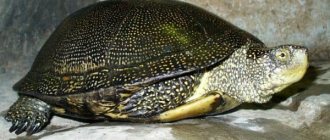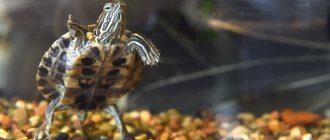Long-livers or is it a myth? They say that the first turtles appeared long before dinosaurs. Large and heavy animals, slowly stepping through all stages of human development, have rightfully earned the title of record holders for life expectancy. If you don’t have time to read all the details, scroll to the end of the article and find out how long turtles live in one picture.
In the modern world, the order of turtles includes more than three hundred species that keep the bar for life span set by prehistoric ancestors. Small and large, slow and clumsy animals have long earned the love of people for their unpretentious disposition, endurance and bright intelligence.
Giant tortoise living on the island of Aldabra (255 years old)
The gigantic tortoises from Aldabra Island are among the largest in the world. The diameter of their shell can reach 120 cm, and their weight is more than 250 kg. Giant turtles can stretch their necks to a distance of a meter, thanks to which this type of reptile is able to obtain food at quite a height. Unlike many other species, giant tortoises can eat anything, and sometimes even members of their own species. They are famous for their extraordinary longevity, but a turtle named Advaita, who lived in the city zoo in Kolkata, was truly a unique animal, as he died at the age of 255 years. Some scientists believe that Advaita is the oldest land mammal that ever lived.
How to find out the age of turtles?
Radiocarbon dating of the shell makes it possible to most accurately determine the number of years. It was this method that made it possible to confirm the age of the oldest turtles in the world. Of course, such research cannot be carried out during life, but there is a more humane method.
Methods for determining age:
- Along the length of the shell. It tends to change evenly. Every year he gains 2 centimeters. It is not so difficult to take measurements and calculate if you know the initial length. The size of newborns is only 3 cm. Calculating the age is not difficult. For example, the length of the shell is 30 cm. If you subtract the initial size from the final size, 30 - 3 = 27, you get the number by which the turtle has grown in its entire life. Dividing it by 2 (the number of centimeters per year), the age is 13.5 years.
- Counting rings. This method is less accurate because it requires careful observations. The method should not be confused with determining the age of a tree; there is no need to cut anyone. You need to count the rings by the scales on the shell. More accurate results can be obtained on young animals. This is because in older individuals they are smoothed out. The turtle is 1 - 2 years old, if there are less than 6 scales. In one year, 2-3 rings are added.
Whatever method is chosen, none gives 100% accuracy of calculations. This is due to the fact that the growth and formation of the shell depends on the health of the animal, its diet and living conditions.
Freshwater mussel (280 years old)
Unfortunately, this species is endangered and is listed in the Red Book. Consequently, freshwater mussels are one of the shellfish species with the greatest risk of extinction from the face of the Earth. The species has suffered mainly due to human activities such as illegal pearling, habitat destruction and the decline of salmon species that play an important role in the breeding cycle. Freshwater mussels grow very slowly, so their average lifespan is between 86 and 102 years, but this largely depends on environmental factors in which they live, such as water quality, etc. The oldest mussel found was 280 years old.
Children with COVID-19 coronavirus infect others for 10 days
They are going to build a 7,000-seat arena in Toronto: photo of an unusual project
At what moments do different zodiac signs become cruel and heartless people?
Reproduction
Depending on the type of turtle, puberty occurs 6 or even 10 years after birth. Females of different species are often larger than males. Males have physical features that facilitate the mating process: an indentation on the plastron, as well as femoral spurs in some species.
Mating displays for turtles in captivity usually occur in the spring and last up to three weeks. At home, the breeding season can be year-round due to the constant availability of food and comfortable living conditions. At this time, reptiles are much more active than usual. Males attract females with yelping calls and fight among themselves over them, leading to serious injury and even death.
2-3 months after mating, females lay fertilized eggs (from 1 to 30 depending on the species) in depressions dug in the ground and bury them.
Turtles living alone in captivity often lay fatty eggs that cannot hatch. But if sexually mature individuals of different sexes live in a terrarium or enclosure, then fertilized eggs are most likely possible. It makes sense to place them in an incubator for hatching turtles, which then must be kept separate from adults. Turtles do not have parental instinct, they do not care about their offspring and can even harm them.
Greenland shark (400 years old)
A frightening look is not the only distinctive feature of sharks living in the waters of Greenland. They are also the oldest living vertebrate to swim the deep oceans. Greenland sharks do not reach sexual maturity until approximately 150 years of age and can live up to 400 years. It is noteworthy that such an impressive life expectancy for this species of shark is not an exception to the rule, but the norm.
Hibernation
Yes, turtles, like
Bears and some other animals tend to hibernate, during which all life processes in their body slow down for a while. This usually happens in winter, and hibernation for heat-loving turtles living in temperate latitudes allows them to survive the winter cold without problems.
Quahog clam (507 years old)
Quahog is an edible species of bivalves. This species lives an incredibly long time, adding one layer to its shell every year. Quahog has exceptional longevity, and a compelling example of this is a clam named Ming, which lived a whopping 507 years, the highest age of any non-colonial animal species.
Not always love: different colors of emoji hearts indicate different feelings of a person
The name should emphasize character traits: what to name your baby in 2021
Aries loves fresh air: the perfect first date for different zodiac signs
Sexual characteristics of a turtle
The sex of turtles is determined by appearance and behavior, since these animals do not have clear genital differences, and it is almost impossible to figure out the sex at first glance. However, males differ from females:
- according to the shape of the shell (in females it is more elongated);
- the lower part of the shell is slightly concave in males, flat in females;
- the tail of males is longer, wider and thicker, it is more curved down;
- according to the shape of the anus;
- in males, the claws of the front paws are slightly longer;
- a small notch in the shell in the tail area is present only in males;
- The behavior of males is characterized by activity.
In some species, gender, in addition to the indicated characteristics, is expressed by the color or shape of the head.
Atlantic roughy (over 110 years old)
This long-lived fish species lives in the depths of oceans around the world. They don't reach maturity until they are 20 years old and can live over 100 years! The maximum lifespan of the roughy is estimated to be 149 years. Today the species is under threat of extinction. Unfortunately, after 30 years of overfishing, the population of this species has decreased by 10-30%. In addition, roughy are often caught in bottom trawling, an activity whereby nets containing massive metal weights are pulled along the seabed, removing everything in their path. The nets have caused enormous damage to the species' habitats around the world. Because of its long lifespan, the Atlantic roughy reproduces and grows very slowly.
No water and no food
Reptiles can live for several days without food or water. Turtles are unpretentious pets and can easily go without water for a couple of days. However, you should not be zealous in setting up the experiment; the lack of water provokes hibernation that does not correspond to the season.
Also, lack of moisture leads to drying out of the shell and the appearance of microscopic cracks, which causes the penetration of infections from the outside.
It happens that the reptile refuses to eat and does not consume food for two months. The reason for boycotting is stress caused by changes in the external environment and conditions.
During a hunger strike, due to slow metabolism, fat is burned, which generally does not affect health in any way. However, if the reptile does not show appetite for a long time, this is a reason to visit a doctor.
Red sea urchin (approximately 200 years old)
If you've ever eaten sushi, chances are you've tasted the reproductive organs of a red urchin. This species can only be found in the waters of the Pacific Ocean. It lives on rocky shores and stays away from areas with intense currents. Sea urchins' bodies are completely covered in incredibly sharp spines, which help them protect themselves as they crawl along the ocean floor. Back in the century before last, scientists believed that the lifespan of these marine inhabitants was only 15 years, but recent research has yielded unexpected results. It turns out that this species can grow and develop throughout its life. Sea urchins age very slowly, so some specimens can easily live up to 200 years. Surprisingly, red hedgehogs are one of the oldest animals on Earth. They existed during the Paleozoic.
Forgiveness Sunday: rituals and traditions of this day
You can’t go to bed late: what you are forbidden to do on Forgiveness Sunday
An American lived in Siberia for more than a month: 5 of his conclusions about Russian people
Origin of the name
If we consider the Slavic and Latin origins of the name of the reptile, it is easy to see the commonality. Both languages demonstrate a response to appearance in the word: translated from Latin “tile”, “clay vessel”, “brick”; from Slavic - “shard”.
Indeed, many turtles resemble the stone for which the people who gave them this name mistook them. Despite this etymology of the name, it also contains an indication of the unique shape and color of the hard shells.
Bowhead (or arctic) whale (211 years old)
The bowhead whale is not as famous as the blue whale, but it has some distinctive features that make it a one-of-a-kind species. Firstly, it has the largest mouth of any animal, and secondly, this creature can live for over 200 years, making it the longest living mammal. The oldest known specimen of this whale species was 211 years old.
What to feed
Since turtles are predominantly herbivorous reptiles, they need to be fed plant foods: vegetables, herbs, fruits, berries or special store-bought food.
If you feed your animal food that you have prepared yourself, then all the food must first be finely chopped and chopped. It is imperative to add vitamins and minerals to your food. In the case of ready-made feeds, this is not necessary, since their composition is balanced and enriched with the necessary macro- and micronutrients.
The best foods for turtles, typical for Russian regions, are apples, carrots and white cabbage. Plus they are cheap and available all year round. In the summer, turtles can be offered everything that grows during this period in gardens, orchards, and even in the city: plantain, clover, dandelion, raspberries, currants, apricots. Large seeds should be removed from fruits and berries before feeding to pets.
Bakery products, dairy, fermented milk, fish, meat products, insects, skins of citrus plants and food for other domestic animals (cats, dogs, parrots and others) are extremely harmful to herbivorous reptiles.
Giant tube worm (up to 250 years)
The giant tube worm lives at depths of 500 to 800 meters, near cold currents, in places where oil and methane escape from the seabed. It lives in symbiosis with oxidizing sulfur bacteria that live on its body. The giant tube worm can reach a length of more than three meters (but grows very slowly) and live up to 250 years. Tube worms usually live in large groups numbering thousands of individuals.
Scientists have discovered why cheese enhances the taste of wine and softens its “unfortunate notes”
Scientists admit the existence of life in subglacial Antarctic lakes
Free, no time for yourself: Shepelev talked about personal space in the house
Enemies in nature
Speaking of enemies, in natural conditions the main enemies of a turtle are some birds of prey (eagles,
hawks), which grab small turtles, lift them to a great height, from there they throw them onto stones and peck out their entrails from their broken shells.
Interesting fact: the great ancient Greek playwright Aeschylus died an extremely ridiculous death, he was killed by a turtle that fell on his head. The eagle, having lifted the turtle to a height, mistakenly considered the playwright's bald head to be a large stone suitable for breaking the turtle's shell.
Death of Aeschylus by an eagle and a turtle.
As for giant turtles, given their weight and size, they have no enemies in nature. Even people are increasingly treating these majestic, long-lived creatures with due respect.
Koi carp (226 years old)
Koi (also known as brocade carp) are a domesticated ornamental species of common carp. In general, brocade carp live up to 50 years, but one pet specimen named Hanako became the longest-living living fish ever recorded. He died at the age of 226, and it is still a mystery why he lived so long. Most scientists are of the opinion that koi simply enjoy life, receive love and care from their owners, and also have the opportunity to swim in the crystal waters of the Japanese mountains.
Found a violation? Report content
Interesting Facts
- It was turtles that were the first to fly around our moon, on board an experimental research probe launched by the Soviet Union back in 1968.
- Turtle meat is an expensive and delicious product in some cuisines around the world.
- Turtles are also present in heraldry, in the depiction of the coats of arms of some cities.
- Despite the fact that turtles do not pose a danger to humans, there are exceptions, for example, male leatherback turtles can confuse a swimmer with a female, grab them with their paws and drag them to the bottom.
- The sex of turtles in the egg is determined by the ambient temperature. At lower temperatures, males are born, at higher temperatures, females are born.
Behavior
The turtle leads an active daily lifestyle. At night she sleeps with her head above the surface of the pond. During the day, they can gather in groups to sunbathe together, taking a liking to the coastal stones and rocks.
Very shy and reacts to any noise. She is able to perceive low sounds with a frequency of up to 3000 Hz, signaling the approach of a potential offender. When the temperature drops to 10°C, it goes into hibernation.
As a rule, it occurs from October to April of the following year. During its passage, the metabolism in the body slows down greatly. Wintering can be carried out in water, hollow tree trunks and other similar shelters.
Video
And finally, here is an interesting documentary about turtles.
Author: Pavel Chaika, editor-in-chief of Poznavaika magazine
When writing the article, I tried to make it as interesting, useful and high-quality as possible. I would be grateful for any feedback and constructive criticism in the form of comments on the article. You can also write your wish/question/suggestion to my email [email protected] or Facebook, with respect, the author.
Author page
Bathing
It often happens that a turtle's skin dries out and peels. The bathing process is one of the important components when caring for a land turtle. Bathing a reptile saves the body from dehydration and helps replenish and normalize the water balance in the body.
The water must be warm, 30-35 degrees. You can bathe your turtle 2-3 times a month. It must be placed in a container with water and left for 20-30 minutes. During the procedure, you need to monitor her so that she does not roll over onto her back.
After bathing, the turtle should be dried with a towel and placed in a terrarium. You should not let the reptile go wet, it may catch a cold.
If the reptile's skin is dry and flaking, then a non-greasy reptile cream is rubbed into the skin and shell for a week.
Spreading
The species is widespread throughout Southern and Eastern Africa. There are two subspecies: the South African (Sp pardalis) and the East African (Sp babcocki). The first has a lighter plastron, while the second has a slightly darker upper body.
Reptiles live in dry semi-deserts, thorny bush and savannahs. They are found both in flat lowlands and in mountainous areas at altitudes up to 3000 m above sea level. Leopard tortoises are adapted to life in low humidity conditions, such as in the Kalahari, where the annual rainfall is no more than 100 mm.
It does not form home ranges, sharing territory with its fellows. The land is in common ownership, and one individual can feed on 480 hectares, but usually feeding occurs on a much smaller area. The love for long walks in search of food is more typical of females than of males.
What to avoid when keeping
Despite the apparent indifference to everything that surrounds it, the turtle can experience severe stress. If Central Asian land turtles live in captivity, they are sensitive to the attitude of their owners towards them. Loud sounds in the house and rude screams disturb the usual calm environment and can lead the animal to a nervous breakdown. Therefore, you should take the following postulates as a rule:
- Be careful when handling the reptile, do not drop the animal or frighten it with sharp sounds. If children play with the pet, adults should supervise the process.
- If you notice anything strange in your reptile's behavior or appearance, do not delay checking with a veterinarian. Refusal to eat, changes in the shape of the shell, lethargy, the appearance of tumors and ulcers are serious signals of illness.
- When purchasing new armored reptiles, quarantine them for a month. At this time, the future neighbor must live separately.
- Do not keep reptiles of different species in the same terrarium.
- If the reptile escaped from the aquarium and cannot be found, place a bowl of water and your pet's favorite food indoors. Turtles have good eyesight and will respond quickly to treats and water.
- Remember that the depth of the reservoir should allow the animal to easily stick its head out and keep it on the surface.
- Install two thermometers in the aquarium: one for water, the other for air.
Arrangement of the aquarium
Proper arrangement of a future place of residence for a turtle will require certain skills and costs from you. When setting up housing for your red-eared slider, you will need to do the following:
- Buy an aquarium. To maintain activity and good health, the turtle will need an aquarium with a volume of at least 150 liters. If you think that you can get by with a smaller container, then your pet will grow with curved shells and sooner or later will begin to get sick;
- Set up a piece of sushi. These turtles do not spend all their time in the water, so they will definitely need a place to walk and warm up. An island for a reptile can be bought at pet supermarkets, which offer a large selection of artificial options for this element of the aquarium. If you decide to set up a terrarium yourself, you need to remember that the turtle should be provided with a sloping climb so that it can easily climb onto land. It could be a stone or a piece of wood. The main thing is that the material is non-toxic, has a surface with a pronounced texture, is stable and does not have sharp corners. The land should occupy about a quarter of the aquarium and be heated;
- Pour soil. By and large, soil is used only for aquarium decoration. Turtles do not need it. However, you can decorate your turtle's habitat to make it look more attractive. Let’s immediately make a reservation that you cannot use fine soil - a turtle can swallow it, and caring for such an aquarium will be problematic. For decoration you need to use only large stones;
- Provide heating for sushi. Wild turtles will often come ashore to bask in the sun, so you need to give your pet the same opportunity. To achieve the required temperature of the shell (31-35C0), you need to place the lamp strictly above the piece of sushi. It is also advisable to install a thermometer, since both overheating and insufficient heating are equally dangerous for turtles. There is no need to place the lamp too low - this can cause burns. In addition, the lamp must be splash-proof;
- Provide UV radiation. Turtles need not only heating, but also proper lighting of their place of residence. Under natural conditions, the body’s production of all the necessary elements for the absorption of calcium and the production of vitamins is ensured by the sun’s rays, but in an apartment, a turtle needs a UV lamp, which, like a heating lamp, must work for at least 10-12 hours a day;
- Pour water. These turtles are a freshwater species, so they spend a lot of time in water. The level of the water surface in the aquarium should be such that the reptile can turn over freely if it suddenly tips over on its back. In general, in this case it is better not to save money - the turtle should be comfortable swimming, and a large volume of water becomes polluted much more slowly. Before pouring water into the aquarium, it must be left for 24-30 hours to get rid of chlorine. Water for turtles should be warm - 22-28C is considered the norm. It is better to periodically check the water temperature to prevent hypothermia and install heating in the aquarium;
- Equip the aquarium with a filter. Turtles not only eat in water, but also empty their intestinal contents into it, so you have to constantly monitor the cleanliness of the water. The best solution is to install an external filter, which will cost you quite a lot. You can install a small internal filter, but in this case you will still have to change the water at least once a week (without a filter - 2-3 times a week);
- Consider a place to install the aquarium. The turtle's housing will have a decent weight - a glass aquarium, water and equipment will weigh a total of 200-300 kilograms, so not every table will be able to hold this load. The place for the aquarium should not be in direct sunlight or in drafts.
We invite you to familiarize yourself with the main diseases of domestic rats











